#Carol is front and center during the wolves attack
Text
Hints of Beth and the CRM War in 5x09
So, after I re-watched 6x08 and 6x09, which I posted last week, I also decided to re-watch 5x09. I did so for various reasons, including a comment I received on an old theory. But mostly, I’d been wanting to rewatch this episode for a while. I had a hunch that there might be hints toward the CRM war in it that we couldn’t possibly have known about or recognized back in S5. I was not disappointed.

Tyreese, Lizzie & Mica:
So, in this new comment I got, this commenter said she thought Ty was likening the twin boys to Lizzie and Mica. And I’m sure this has been discussed in some iteration, but I sat and thought about it in a way I hadn’t before. I know I’ve discussed that it seems, from the photos, that there seemed to be a “good” and “evil” twin, and obviously that has ties to Lizzie and Mica. But just think about it this way. Ty was obviously present for the Lizzie/Mica tragedy. Then, he’s killed by one of these twins as a walker.
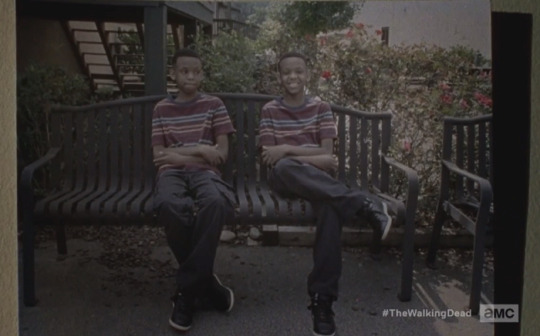
A random line from 5x04, 4 Walls and a Roof, came to my mind. After Abe and co get on the short bus to go to D.C., Ty is digging graves (for the Termites they killed) and Rick goes to help him. Rick asks him something about what happened on his way to Terminus or something like that (can’t remember the exact question) and Ty answers that what happened “killed me.” Rick, looking a little annoyed, says, “No, it didn’t.” And that’s it.

But it occurred to me that Ty’s line is a foreshadow. He was speaking about Lizzie and Mica, saying that their deaths killed him (emotionally) but it was a foreshadow that another set of siblings would actually kill him a few episodes later. I don’t have a whole lot more to say about this particular thing, though I’m going to talk more about Ty in a minute.
The thing is, I really don’t think we understand the point of Lizzie and Mica, yet. We’ve had lots of theories, talked about how they impacted Carol, the ways in which they could be Beth proxies. But I don’t think we understand their significance in the grand scheme of things, and I’ve never quite known what to do with them symbolically. But given that they’re in Ty’s hallucination WITH BETH tells me we will probably figure it out when she returns.
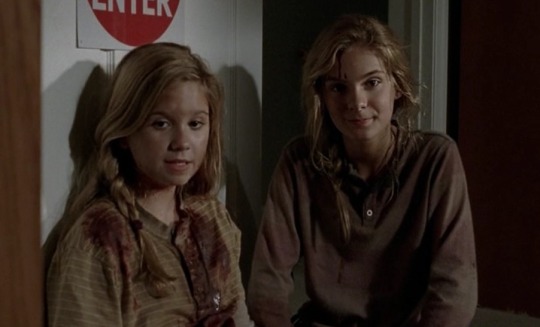
Hints of the CRM in 5x09:
Several years back (like during S6) I tried so hard to figure out what the radio messages in 5x09 pointed to, and couldn’t really come to any solid conclusion about them. Of course, back then we knew absolutely nothing of the helicopter people, so how could I?
We’ve definitely seen some of the things they talk about come to pass, both before and after this episode. They mention prisons (prison fell before this) and setting people on fire (Carol did that both in S9 and also to Karen and David in S4) and of course they mention machetes (Red Machete). All important symbols.

But these messages also tell a story. Look at what they say:
“At least 68 citizens of the Republic have been killed in four deadly attacks along the main coastal district. The group has continued their campaign of random violence, moving across the countryside unfettered, with the Republic’s military forces in disarray.”
Okay, so I’m assuming the “republic” is the CRM. This suggests a different group performing guerilla warfare against them. Think about all the symbols these lines encompass. We have a group of rebels attacking the CRM, the COASTAL district, and of course the CRM itself. So it’s talking about some rebel group that will be fighting against the CRM.
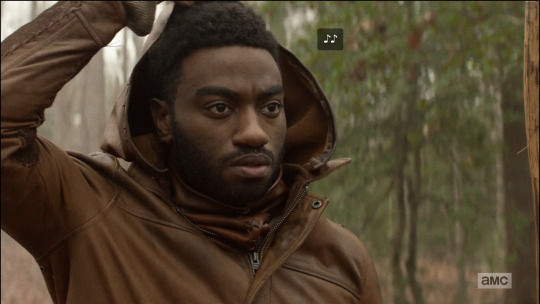
I think that’s super significant, especially because of the TWB template. Remember that we saw a group of rebels, perhaps led by Will, though it’s a little unclear as yet, who is Beth’s proxy in that template. And they’re outside the CRM and, presumably, because they saw the slaughter at the college, going to fight against it. So I’m seeing this as a huge hint for Beth’s return.
The other thing to bring into the mix here is the Wolves. Because all of this in 5x09 definitely foreshadowed the wolves, and it’s where we first saw their “WOLVES NOT FAR” signs. And where did we see TONS of Beth symbolism: around the wolves.

Second message: “…then terrorizing the village by night, carrying out revenge attacks which include hacking innocents with machetes, and in some cases setting them on fire.”
Okay, so I get that this isn’t flattering for Beth or her group if she’s with the rebels, but it is really hard to know what they’re talking about here, since we don’t get the full sentence. The point is, these are acts of war, and even if this is talking about the rebel group doing this (and I think it probably is, given that wolves did all of these things a few episodes later in 6x02) it’s no worse than what we’ve already seen the CRM do.
But I can also see that if Beth is with or leading this group, this is a very Grady-like issue to be dealing with. Are we killing these people for the greater good, because the war needs to be won? You can see how Grady could easily have been a setup for what she’d be dealing with later on. And maybe she’s the “new sheriff” because she has to police her own people and not let them get too blood thirsty. Or maybe I’m reading into this WAY too much and the point is simply that there will be a violent war. ;D
There’s only one more message that comes out of the radio. So we had the first one, talking about the CRM war and a rebel group attacking the CRM. Then talk of wartime violence.
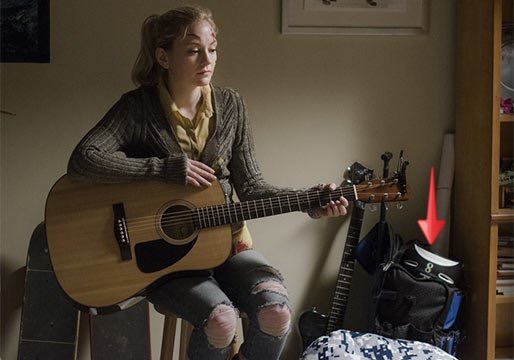
The third message is Beth singing her song. That’s super on-the-nose, if you ask me. No more clear way to say that Beth will be part of the conflict the radio voice was just talking about. See why that made me happy?
Tyreese…Again:
I’m gonna make a sweeping claim, here. I think the themes around Ty’s death are pretty much the point of the entire series. Yes, I know that’s a tall order. Let me explain. It does tie heavily into Beth’s return, but it encompasses other things as well, and I think it’s a huge part of the current Negan/Maggie/forgiveness story line.
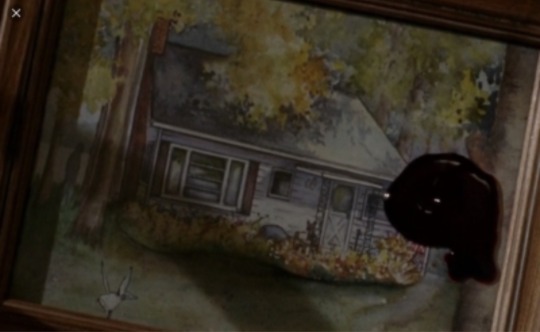
So, when I first went to watch 5x09, I pulled up S5 on Amazon and it shows all the episodes, the first one, of course, being 5x01. And the little picture it had for that episode was Ty in the cabin with baby Judith. I sat and thought about that and that there’s the picture of a cabin in 5x09 that gets blood on it and it occurred to me that those two things are probably related.
So I watched 5x01 after watching 5x09. I’ll admit I didn’t see tons of smoking guns that haven’t already been discussed at length in 5x01. The biggest thing is simply that it was a setup for Ty’s death themes in 5x09, and I definitely need to revisit my cabin theories. ;D

So, if we look at the people Ty hallucinated, there’s the Gov, Lizzie, Mica, Beth, Bob, and Martin, right? These are all obviously people and events Ty feels guilty about. Bob’s death, because he lied about Martin and that sent the Termites after them. He feels guilty about being duped by the Gov and not realizing what a bad guy he was. Lizzie and Mica for obvious reasons. And Beth.
I honestly don’t think Tyreese did anything to feel guilty about with Beth. Not in the same way we think Sasha might have (Sasha/Tyreese Theory). But based on what the Martin hallucination says, I think he’s just really broken up about it and wondering if he could have done anything to change it. Just my opinion, though.
So, if you listen carefully to who is saying what in the hallucination, we have two different representations of good and evil. There’s 1) Bob vs. Martin and 2) Beth/Lizzie/Mica vs. the Gov. In each case, they’re like good and evil angels sitting on Ty’s shoulder and they’re arguing.
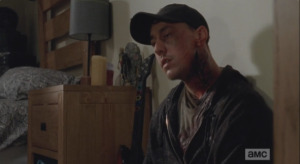
So, for example, Martin says the thing about Ty lying about his death and how, maybe somehow, if Bob hadn’t died, it would have changed things with Beth. Domino shit. And then Bob says [paraphrasing] “No, that’s bullshit. I got bit at the food bank. It went the way it had to. The way it was always going to.”
And we have the same thing going on with the Gov. He’ll basically tell Tyreese what an idiot he is, and then one of the three (Beth/Lizzie/Mica) will say, “No. It’s all right. It’s better now.”

So, you can see that Ty is really at war with himself internally.
It’s important to note that one big thing that’s mentioned is that he forgave Carol for Karen’s death. The Gov actually says that Ty is weak and ridiculous because he sat across the table from a woman that murdered someone he loved, and he actually forgave her. The Gov really razzed him about that.
And this is one of the things I mean about over-arching themes. Carol killed Karen and David in S4, which we all know was one great big foreshadow of arcs to come, and Ty forgave her.
I really think this was probably meant to be a foreshadow of Negan. Negan’s story, killing Glenn, was a way bigger deal and way more front and center, mostly because no one really knew Karen except for an episode or two and Glenn was such a beloved character.
Now, we have this redemption arc for Negan and Maggie is going to have to decide if she’ll forgive him, moving forward. We could apply this to plenty of other story lines where Rick took the violent route or forgiveness wasn’t had, and it leads to trouble and death. So, I think this is pretty huge for the overall show.
And I really think it points to Negan doing something to save TF in some way. Because they forgive him and he’s allowed to live, that will save lives. We’ve talked about this with Daryl showing Dwight mercy as well.
My Biggest Beth Takeaway:
As the episode progresses, before Rick and Michonne come to get him, Tyreese does finally stand up to the Governor. He says that the Gov was a bad guy, and that wasn’t his (Ty’s) fault. He says what he talked about with Noah: that he never turned off the radio. He always faced it, and did what he could to help. He said he forgave Carol specifically because “it’s not over.” Which I take to mean that he has hope for the world’s future, and forgiveness is the only way forward. Being angry and holding a grudge only brings death.
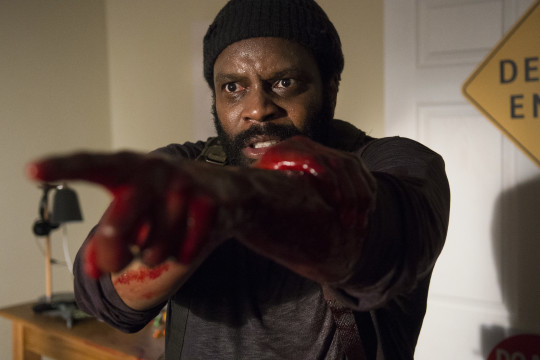
And then he said the thing that jumped out at me most:
“People like me CAN live.”
Okay, so what does he mean by ‘people like me?’ Because obviously Ty didn’t live, so this doesn’t apply to him directly. Or if it does, he means that he’ll die, but people like him CAN live under some circumstances.
To figure this out, we have to go back to his cabin in 5x01. During that entire scene in No Sanctuary, Martin was giving him crap about being a “good” guy. Ty answers, “you don’t know what I’ve done.” And Martin looks at baby Judith and says, “no, you’re a good guy. You save babies. That’s a little like saving an anchor when you’re without a boat in the middle of the ocean.” (Total boat/water reference.)
So, when Ty says “people like me,” he means those who choose to be good. Who choose to be hopeful and moral, rather than violent. There’s a long-running theme in the show that Chris Hardwick mentions a lot, that people who function as the moral compass of the group often die. And that’s true.
But here, Ty says, “people like me” (meaning the moral compasses) CAN live.
And Beth is in the room with him when he says that.
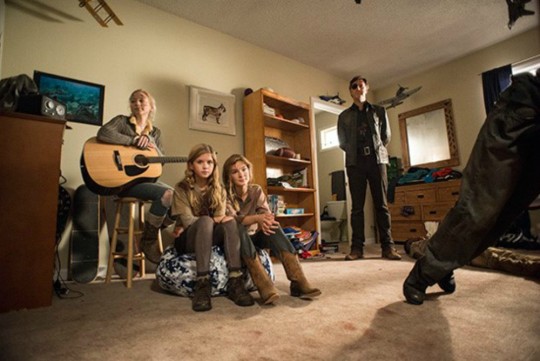
She’s looking at the clock radio that simultaneously reads 5:10 (music box) and also 8:22 (Resurrection).

The skeptic might argue that all these other people are in the room too, and how can we be sure he means her? Well, putting all the mountains of TD evidence aside, they do have a point. After all, all the “good” characters Ty hallucinates (Bob, Beth, Mica) are moral compasses and fit the criteria. There are plenty of others not represented here (Hershel, Dale, Glenn, Denise, even Abraham to an extent) but these are the ones Ty felt particularly guilty about.
But I would argue that we only heard one person’s voice come through the radio: Beth’s.
So once again, look at this from a bird’s eye view. Talk of the CRM and a coming war. Then Beth’s voice comes through that same radio, suggesting she’ll be part of it. And later on, “people like me CAN live.”
See what I mean? As I told my fellow theorists, this episode really had all we needed to predict Beth’s return. We just couldn’t have understood the meanings back then.
And honestly, this may be the explanation for the Lizzie/Mica thing I mentioned above. It’s a representation of the evil killing the good, which is super traumatizing and messes everyone up because as humans, we’re hard-wired to believe good will win out.
So, we had Lizzie/Mica, Noah’s brothers, and then the good vs evil hallucinations I already talked about. And we might even have a representation of this at Grady because of evil officer Bob.

We had good Bob who died in 5x04, and then Evil Officer Bob, who directly led to them only having two prisoners, which directly led to Beth getting shot. And I remember when it aired, the show brought a lot of attention to it by doing clickbait articles about why there were “two Bobs.”
So, it’s something they wanted us to notice. And then we see Bob in Ty’s hallucination here. I gotta think that Sasha and Ty’s sibling relationship plays into this in some way as well.
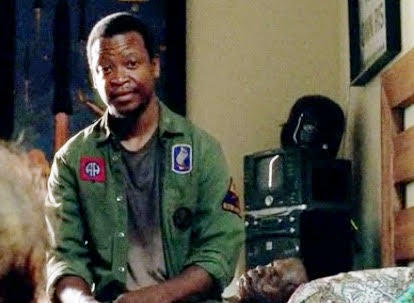
Okay, I’ll shut up, now. But re-watching this gave me tons of hope. We can’t say for sure that we’ll see her in the bonus episodes (though obviously I hope we will) but I’m more sure than ever that she’ll be part of the CRM war. And we’re kind of on the cusp of that. We just have to sit back and wait. ;D
#beth greene#beth greene lives#beth is alive#beth is coming#td theory#td theories#team delusional#team defiance#beth is almost here#bethyl
14 notes
·
View notes
Photo

THE MONGOL WARRIOR DURING THE REIGN OF GENGHIS KHAN, ARMAMENTS AND TACTICS
This is an expert from my post “THE MONGOLS AND THE RISE OF GENGHIS KHAN”.
“It is an army after the fashion of peasantry, being liable to all manner of contributions and rendering it without complaint whatever is enjoined upon it… It is also a peasantry in the guise of an army, all of them, great or small, noble or base, in time of battle becoming swordsmen. Archers and lancers and advancing in whatever manner the occasion requires.” – Ala-ad-Din Ata-Malik Juvaini, Persian historian and governor of Baghdad.
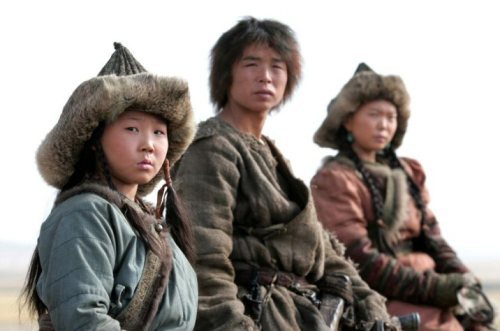
Mongols began their journey into maturity at a young age; around the age of three their mothers taught them to ride horses, being able to ride alongside their parents at the age of four and able to race at the age of six. At the age four or five they were given their first bow and by the age of fourteen or fifteen they were old enough to be enlisted into the army – possibly acting simply as herdsmen or members of the baggage train.
“-their children begin as soon as they are two or three years old to ride and manage horses and to gallop on them, and they are given bows to suit their stature and are taught to shoot; they are extremely agile and also intrepid. Young girls and women ride and gallop on horseback with agility like men.” – Giovanni of Pian del Carpine.
Military training wasn’t as necessary for Mongol recruits as by this time they had already spent years herding and hunting on horseback; learning how to track, pursue, carol, and kill game. In particular they engaged battues, or ‘nerge’; a great hunt in which “beaters” spent a month driving animals into a certain pre-chosen area which would then be encircled and closed off.

^ Kublai Khan on a hunting expedition.
“When in a battue we hunt the cunning wild beasts, for you we shall go ahead and round them up. For you we shall drive the beasts of the steppe until their bellies press together; for you we shall drive the beasts of the steep banks until their thighs press together.” – The Secret History of the Mongols.
“When ordered to go ahead and round up wild beasts in a battue, for you I would have driven the beasts of the cliffs Until their forelegs pressed together. For you I would have driven the beasts of the steep banks until their thighs pressed together. For you I would have driven the beasts of the steppe until their bellies pressed together.” – The Secret History of the Mongols.
“These Mongolian wolves are big and savage, often attacking the herds, and one alone will pull down a good horse or steer. The people wage more or less unsuccessful war upon them and at times they organize a sort of battue. Men, armed with lassoes, are stationed at strategic points, while others, routing the wolves from their lair, drive them within reach.” – Elizabeth Kendall.

As the circumference of the battue circle closes in, the wild beasts are forced into a confined region, they are then shot down. First to be given an opportunity to hunt choice game were the nobility and royalty who would then open up the hunt to their remaining troops. Wild game hunted consisted of foxes, hares, swans, cranes, deer, gazelles, cattle, wild boars and wild asses, but also included more dangerous animals like wolves, Siberian tigers and bears.
“When they want to hunt wild animals they gather together in a great crowd and surround the district in which they know the animals to be, and gradually close in until between them they shut in the animals in a circle and then they shoot them with their arrows.” – William of Rubruck.
During Genghis’ campaign against the Khwarezmian Empire of Greater Iran, he felt that his reserves had spent too much time away from battle and would eventually grow soft and weak. To alleviate this he ordered them to engage in a great battue (the great khan also joined in) which encircled a vast area and killed off all game within. The battue were not only for sport, they also trained the Mongol warriors in cooperation, coordination, discipline, marksmanship, tracking as well as luring the enemy toward a chosen battlefield.
Other skills these young Mongols attained throughout their lifetime were scouting and knowledge of vegetation, environment, weather and climate. These Mongols would continue campaigning for most of their lives but all the while these warriors weren’t paid, their only form of income came from raiding, looting and from a portion of the war booty. They would then give the Great Khan all of the loot, he would take 10% then distribute the rest to his highest commanders who would then distribute to those below then and so on. Some of the loot was also given to the orphans and widows left behind by fallen Mongol soldiers.
Appearance:
“… In appearance the Tartars (Mongols) are quite different from all other men, for they are broader than other people between the eyes and across the cheekbones. Their cheeks also are rather prominent above their jaws; they have a flat and small nose, their eyes are little and their eyelids raised up to the eyebrows. For the most part, but with a few exceptions, they are slender about the waist; almost all are medium height. Hardly any of them grow beards, although some have a little hair on the upper lip and chin and this they do not trim … They also have small feet.” – Giovanni of Pian del Carpine, who traveled as the Pope’s ambassador to the Mongols between 1245 and 1247 CE.
Similar to the hairstyle we usually think of when we think of Christian monks, the Mongols had the tops of their heads shaved. The hairline above the forehead and temples was grown out with hair hanging from the center reaching as far as the eyebrows, sometimes there would be two locks of hair at the hairline’s ends. They also allowed the hair on the back and sides of their heads to grow, with two locks of hair hanging either behind the ears or down the sideburns. Generally, the Mongols were bow legged (from horse riding) and short, their baggy clothing made them look all the more stout and stocky.
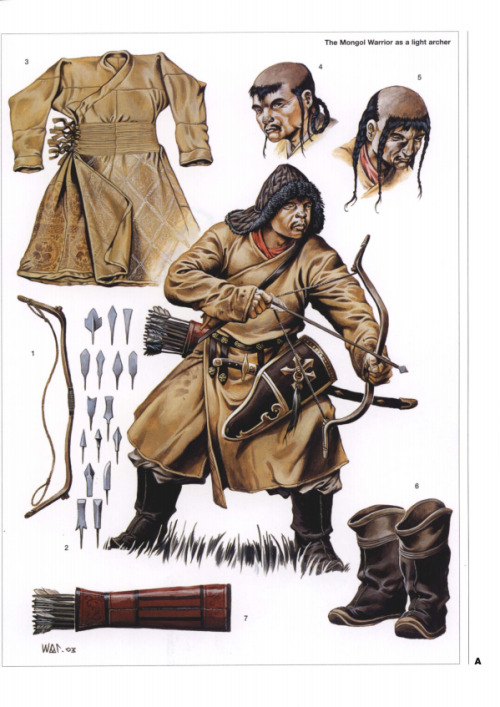
^ Osprey – ‘Warrior’ series, issue 84 – Mongol Warrior 1200-1350 by Stephen Turnbull and Wayne Reynolds. Plate A.
Like most other people whom lived in the frigid and bitter northern regions of the world, the Mongols generally wore many layers of clothing, usually in the form of furs or padded cloths. The Mongols wore long-sleeved shirts under long knee-length robe-like coats made of cotton, wool or leather which had a belt wrapped around the waist. If necessary they would add a coat or two, if both coats were used then the innermost one would have the furred side facing their person and the outer one with the fur facing outward to aid against the weather – rain, winds, snows (according to William of Rubruck). Both their robe’s sleeves and their trousers were wide, with the latter being tucked into their leather or felt high boots.
As they campaigned against Chinese and Islamic nations, they were increasingly accustomed to finer fabrics and materials such as silk. Silk shirts were supposedly capable of, if worn under leather lamellar armor, causing arrow points that penetrated the armor into twisting and lessening the impact. They wore thick socks made of felt (wool) and wore the traditional ‘Mongolian cap’ which consisted of a conical made of quilted cloth, felt or fur and a brim encircling the sides and back of it which could be folded to further warm the wearer. During warmer seasons and in more humid climates the Mongols wrapped a cloth around their head which was eventually tied in the back in the form of a headband.
The Mongol Warrior
During the kuriltai of 1206 CE a white standard was raised (“They hoisted the white standard with nine tails”), this banner (‘tug’) consisted of a long pole with a circular top with nine white tails (yak or horse) hanging down from it. White haired tails were used in times of peace, which is why the one was raised when the Mongols were united at the kuriltai of 1206 CE was white. Black haired tails, however, were raised during times of war. In front of the Great Khan’s ger (tent) were the ‘Nine White Banners’: one in the center, which was the tallest, and eight others surrounding this central banner.
“As for me, I have consecrated (sprinkled) my standard which is visible from afar; I have beaten my bellowing drum covered with the hide of a black bull; I have mounted my swift black horse; I have put on my armor (‘steel-hard dress’) and grasped my steel spear; I have placed on the bowstring my arrow with its nock of wild peach bark. I am ready, let us start and give battle to the Qa’at Merkit!” – The Secret History of the Mongols.
“Then say to them, ‘My long (streamers of horse or yak tails) standard, visible from afar, I have consecrated; I have beaten my deep-sounding drum covered with ox-hide; I have mounted my swift horse, the one with a black stripe along the backbone; I have put on my leather-strapped breastplate, and grasped my hilted sword; I have placed on the bowstring my nocked arrow. I am ready, let us fight to the death against the Uduyit Merkit!’”
Genghis Khan (“To those who sided with me when I was establishing our nation, I shall express my appreciation”) assigned eighty-eight of his companions to the rank of commander (despite their ethnicity, religion or social class). Most of these men would lead a single tumen (‘ten-thousand’) each – Jebe (‘the arrow’) and Jelme (‘blood sucker’) were two of them. Each commander was given a great drum (naccara); if this drum was struck once it signaled that it was time to prepare their horses for travel and place their equipment on them. The second beating indicated that it was time to disassemble and organize their tents and the third pounding indicated that it was finally time to move off from camp. All this was done in silence: when moving off from a camp site, during combat and when preparing camp.
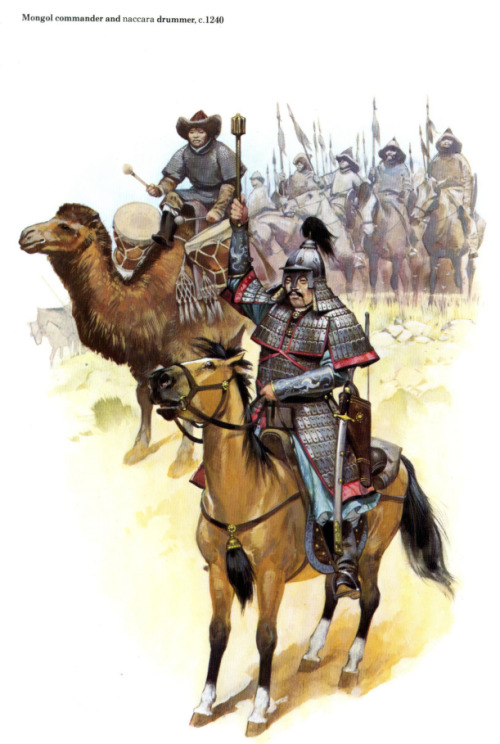
^ Osprey – ‘Men-at-Arms’ series, issue 105 – The Mongols by Stephen Turnbull and Angus McBride (Illustrator). Plate C.
“It is like a very tall whistle of bronze or copper and across the top of it there is stretched a large piece of leather… and this is supported by four stakes as high as a man’s waist… and if the chieftain wished to move camp, when midnight is passed he orders the drum to be struck and the man who is allotted this task grasps two wooden maces in his two hands… and strikes as hard as his strength and breath allow him to do.” – Friar David of Ashby.
In their eerie silence these white and black banners would signal the light cavalrymen to attack or retreat while the naccara (war drums) were banged as a signal for a full-on assault including heavy cavalrymen. The silence would be replaced with the maddening howls and yelling of the charging horsemen which would force the enemy into fleeing. One reason for the silence was so the horsemen could keep a low profile, they would draw little attention so the enemy wouldn’t expect their sudden assaults until it was too late for them to react effectively.
The steppe nomads were known to use a decimal system as an organizational structure, the Mongols too utilized it. In this system a commander or officer only needed to communicate with the ten below them – making the passing of orders and intel much easier and faster.
Arban – a squad of 10 men. This was the smallest unit size; the oldest person in this squad would usually take on the leadership role.
Jagun or zagun – 10 arbans equaling 100.
Minghan – 10 jugans equaling 1,000.
Tumen – 10 minghans equaling 10,000. Though a tumen didn’t always reach ten thousand, sometimes being bolstered by auxiliaries (5,000) which could make up to half of the Tumen’s full size. Temujin would also make it illegal under penalty of death to change into another unit. This often separated sons from fathers, siblings and cousins so this essentially broke familial loyalties. Now no matter your ethnicity, religion or previous clan and tribal associations, your squad became your new family.
Like most other steppe cultures, the first weapon that comes to mind is the bow. The Mongols typically carried two bows with them, one short and one long, both of which were held within their own individual bow cases. The shorter bow was used for short range attacked while the longer compound reflex bow could reach between a range of 200-300 meters (656-984 ft.) with an account of a man called Yesüngge (Genghis Khan’s nephew) able to shoot “a target at 335 alds (536 m. or 1,758 ft.)“.
They also brought along two to three quivers, each holding about thirty arrows each. These bows were pulled back by way of the so-called ‘Mongolian Draw/Release’, in this style the index and middle finger are abandoned in favor of the thumb which was then supported by index and middle finger which rested atop the back of the thumb. The Mongols would wear a ring which allowed faster and more powerful shots. These rings could be made of bone, horn, stone, leather, metal and other materials.
“Every [Mongol] is ordered to carry into battle sixty arrows, thirty smaller ones for piercing and thirty larger with broad heads for discharging at close quarters. With these latter they wound one another in the face or arms and cut through bowstrings and inflict heavy loses.” – Marco Polo.
Primarily there were two types of arrows used, light arrows with small arrow heads which were used for long range and heavier arrows ones with broader arrow heads that made them powerful armor-piercing missiles (due to the fact that they were heated until red-hot then dipped into salt water) used at close quarters (range of 150 yards and much deadlier at close range). A whetstone was attached to a quiver, this tool was used to file and sharpen arrowheads and blades. The greater majority of the Mongol army consisted of light cavalrymen (six in ten) so most wore little to no armor and used small swords, bows and javelins.

^ Osprey – ‘Warrior’ series, issue 084 – Mongol Warrior 1200-1350 by Stephen Turnbull and Wayne Reynolds (illustrator). Plate B.
Heavy cavalrymen, despite rarely being thought of, were an important and integral part of the Mongol army. Armed with scimitars, axes, and twelve foot long lances with a hook near the tip used to yank men off their horses. These elite warriors wore cuirasses consisting of five segments of leather which were boiled in order to soften them (in effect creating a flexible piece of armor) then they were tied to each other. The leather segments would also, with the help of lacquer, become waterproof. This lamellar-like style of armor was also implemented into the creation of greaves and even horse armors.
“One on one side of the horse and one on the other, and these stretched from the tail to the head and are fastened to the saddle and behind the saddle on to its back and also on the neck; another section they put over its hindquarters where the ties of the two parts are fastened and in the last named piece they make a hole for the tail or come through; covering the breast is another section. All these pieces reach down as far as the knees or joints of the leg. On its forehead they put an iron plate which is tied to the aforementioned sections on each side of the neck.” – Giovanni of Pian del Carpine.
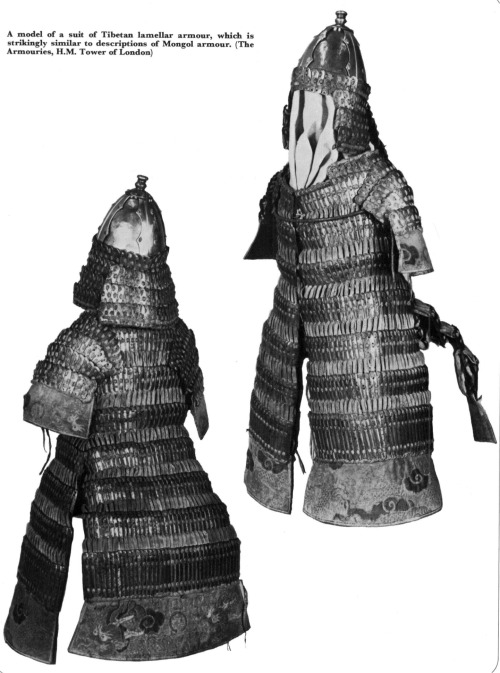
^ Osprey – ‘Men-at-Arms’ series, issue 105 – The Mongols by Stephen Turnbull and Angus McBride (Illustrator).
Another form of leather armor worn was scale armor which consisted of thin but long scales of leather (20 lbs.) designed in lamellar-like fashion. According to Friar William of Rubruck, a Flemish (Dutch Flanders) missionary (Franciscan) and explorer who traveled throughout the Mongol Empire, the Mongols attained iron caps and iron plated armors from Persia. They used lassos, swords (scimitars from the Turks), light axes, maces, spears, lances and small round shields. Lances, however, are mentioned as being their primary weapon. These lances featured a hook which was used to pull enemy combatants off from horseback and yank shields so to open the enemy up to an attack.
A common battle tactic used by the Mongols was the Tulughma, or ‘standard sweep’; arranging themselves in a checkerboard-like formation similar to the Roman Republic’s manipular formation. This granted them free space to maneuver so the light horse archers that lay in the back rows to snake through the heavy lancers divisions in the front rows while the light cavalrymen at the wings weave around them to flank the enemy.

^ Tulughma or “standard sweep”. Osprey – ‘Men-at-Arms’ series, issue 105 – The Mongols by S. R. Turnbull and Angus McBride (Illustrator).
The horse archers would then blot out the sun with flurries of arrow fire and once they were successful in sending the enemy into disarray, the heavy cavalry lancers would stride forward and smite the enemy or force them into routing. If the arrow volleys did not sufficiently stagger the enemy and the light cavalry archers were forced to retreat they would make their way back behind the safety of their core force while letting loose Parthian shots, their place would be recycled by another. The light horse bowmen and heavy cavalry lancers would then engage in a cascade of alternating assaults echoing the actions of the Parthians that obliterated the Romans at the Battle of Carrhae in 53 BCE.
The Mongols tie branches to the tail of their horses to create a blinding storm of dust or sand which could obscure an escape or grant the illusion of a larger Mongol force. Like the Persian Immortals, most of this was done in complete silence from the soldiers. Directions were given by lanterns. the beating of drums, cracking of whips or the waving, raising or lowering of flags. The Mongols would strive to surround and outflank the enemy but they always allowed the enemy an outlet to flee through since cornered rats fought ever fiercer. If the enemy are in dire straits, were given an escape route and followed it then they would be chased and hunted down by the Mongol warriors.
“If it happens that the enemy fight well, the Tartars make way of escape for them, then as soon as they begin to take flight and are separated from each other they fall upon them and more are slaughtered in flight than could be killed in battle.” – Giovanni of Pian del Carpine.
“When you surround an army, leave an outlet free. Do not press a desperate foe too hard.” – Art of War by Sun Tzu.
Back in 1204 CE, two years before he was declared Genghis Khan, he set out against To’oril, Jamuqa and the Naimans. For the most part much of Mongol warfare consisted of unorganized skirmishes and the individual warrior’s skill but in this battle Temujin shows how he successfully employed three different battle formations which overwhelmed the enemy.
“[Temujin] rode against them and, having driven away their patrolmen, he arrayed his troops and together with the army leaders decided to advance in ‘caragana’ marching-order, to stand in ‘lake’ battle-formation and fight a ‘chisel’ combat” – The Secret History of the Mongols, 195.
One such formation was the Caragana (peashrub of Siberia, Mongolia and northern China) also known as the ‘Moving Bush’ or ‘Tumbleweed’ Formation: instead of a full-scale assault on the enemy, the Mongols split up into arbans (squads of ten men each) and peppered the enemy from any and all directions. The Mongol arbans would act almost independently of one another, advancing and retreating. The enemy wouldn’t know where the next attack or wave would come from and which to advance against. Since the skirmish began in the darkness of the early morning the Mongol numbers were obscured. This formation was usually used during dark, cloudy or foggy days and under the cover of darkness (dusk till dawn).

The next phase of the battle was followed by the so-called ‘Lake Formation’ which mimicked the waves hitting the shore. The Mongols would form up in horizontal lines and harass the enemy like a wave. They would then retreat back through the gaps of the new wave of assailants and prepare for their next wave. After performing this formation the enemy formed up into a thin line in order to meet the Mongols. Now forcing the enemy into spreading and thinning their ranks out, the Mongols changed to the next formation in their strategy.
The next stage was the so-called ‘Chisel Formation’: the Mongols narrowed their vanguard whose ranks behind it widened – like an arrowhead. This formation is similar to the more well-known ‘Wedge’, ‘Draco’, and ‘Boar’s Snout’ formations. This formation would allow the concentrated Mongol vanguard to break through the thinned out enemy line. The enemy was unable to keep up with the shifting tactics of the Mongols; overwhelmed and outmatched, the enemy were no match.
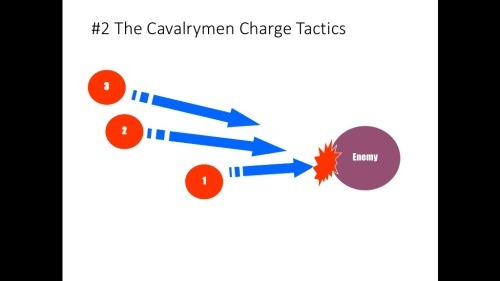
Another popular tactic was the ‘Crow Swarm/Soldiers’, ‘Ocean Waves’ or ‘Falling/Scattered Stars’: this was sort of like the ‘Moving Bush Formation’. Like the ‘Moving Bush Formation’ they utilized small bands which surrounded the enemy, even if the enemy had a larger army. The difference here was that these small bands were at least half the size of the Moving Bush’s. At the beating of a drum, fire signals, crack of a whip or a shout, the small bands all attacked in unison like a massive oceanic wave. This raucous assault was then followed by a silent retreat and repeated if necessary.

KESHIG: THE GREAT KHAN’S SECRETIVE ORDER OF ELITE GUARDS
In Mongol tribal societies, assassinations were common and loyalties shifted like the sands of the great Gobi Desert. Warriors swayed from leader to leader, whichever granted them the most potential profit and fit their immediate needs. Being that these steppe nomads lived in tents it was not that difficult for someone to slip in and kill someone else, because of this Genghis Khan created a band of bodyguards numbering some one hundred and fifty sworn followers (keshig or Keshik, “blessed or favored”); seventy day guards (Torguud) and eighty night guards (khevtuul).

^ Mongol (2007). My snapshot.
“[Genghis Khan] chose and recruited eighty men to serve on roster as nightguards and seventy men to serve as dayguards. He recruited them from the sons and younger brothers of commanders of a thousand and of a hundred, as well as from the sons and younger brothers of mere ordinary people, choosing and recruiting those who were able and of good appearance.” – The Secret History of the Mongols, 191.
Day and night shift:
“Chinggis Qa’an further ordered: ‘The quiverbearers, the dayguards, the stewards, the doorkeepers and the grooms are to go on roster duty in daytime. Before the sun sets they shall see to make way for the nightguards; they shall go out to their geldings and spend the night there. At night, the nightguards shall see that those of their men whose duty it is to lie all around Our tent do so, and they shall put on roster those of their men whose duty it is to stand at the door to guard it. The following morning, when We eat soup, the quiverbearers and the dayguards shall report to the nightguards; the quiverbearers, dayguards, stewards and doorkeepers shall all carry out their respective tasks and take their appointed places.” – The Secret History of the Mongols. 192.
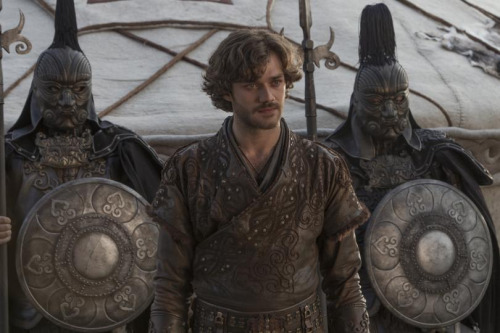
^ Marco Polo (Netflix TV series).
This elite bodyguard eventually grew from a group of 150 men into a full tumen (unit of ten-thousand men) and would continue to be used by the Turco-Mongol led Mughal Empire of India (Khishig) and the Turco-Mongol led Il-kanate of Greater Persia (Keshikchi). Even the famed Venetian merchant and traveler Marco Polo is suspected to have been part of this secretive order, his deep knowledge of Mongol society and his closeness to the Khan (Kublai Khan) hints towards some sort of special relationship. The Keshig not only operated as a system of elite bodyguards but also as administrators, overseers and as a military academy that could lead its members into the position of commanders of a tumen (ten-thousand). Many of the Keshig were sons of high ranking Mongol commanders over tumens and minghans (thousand). By allowing their sons into this order the Great Khan was effectively using them as hostages.
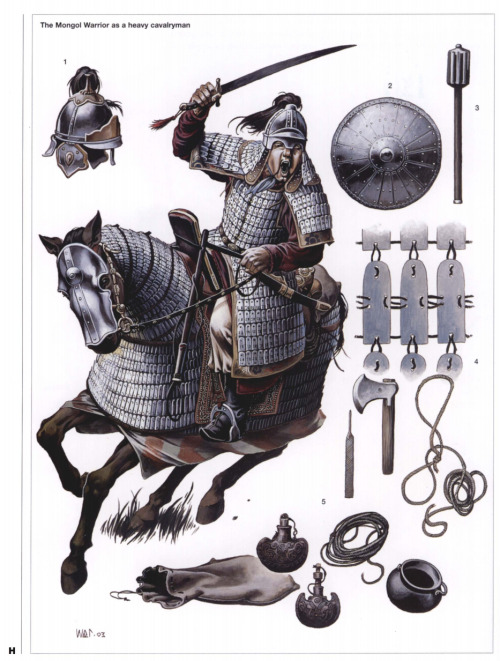
^ Osprey – ‘Warrior’ series, issue 84 – Mongol Warrior 1200-1350 by Stephen Turnbull and Wayne Reynolds. Plate H.
As a whole, under Genghis Khan’s rule steppe armies became far more professionalized. Before commencing march, the commanders and officers had to inspect their men’s gear, equipment and supplies – every piece of armor or weaponry had to be in good condition. The Mongols brought with them needle and thread to keep their clothing and armor in good condition. Only after the inspection had been passed could the Mongols continue on their campaign.
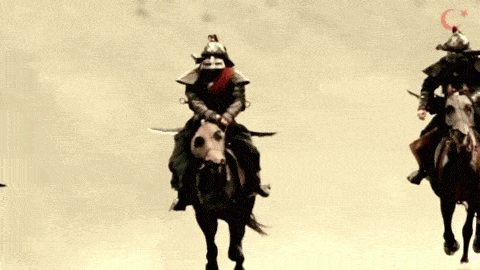
^ Mongol (2007).
While on the march or in battle, any item that was dropped must be picked up by the man behind the owner; be it a bow, sword, sowing needle or whip – failing to do so could result in being executed. There were certain people who searched throughout the deserted camp site for any belongings that may have been accidentally left behind. Other acts that were punishable by death were desertion, fleeing from the field when not given such order, looting the fallen before given permission and guards found sleeping on their watch. Lesser infractions resulted in the penalty of being caned; the number of times struck depended on how many times you’ve stepped out of line.
“When they are in battle, if one or two or three or even more out of a group of ten run away, all are put to death; and if a whole group of ten flees, the rest of the group of a hundred are all put to death, if they do not flee too. In a word, unless they retreat in a body, all who take flight are put to death. Likewise if one or two or more go forward boldly to the flight, then the rest of the ten are put to death if they do not follow and, if one or more of the ten are captured, their companions are put to death if they do not rescue them.” – Giovanni of Pian del Carpine.
“The first failure of a guardsman to appear on duty is to be punished with 30 strokes, a second failure with 70 strokes and a third failure with 37 strokes and expulsion from the guard…” – The Secret History of the Mongols.
Head over to my post, “GENGHIS KHAN, THE STALLION WHO MOUNTS THE WORLD”, to read more about how Genghis Khan was pressured into campaigning out of China toward Central Asia (Kara Khitai Khanate), to Greater Iran (Khwarezmian Empire), to the frontier of Eastern Europe (Medieval Russia and Ukraine) and back to China. I also cover Mongol shamanism and their tolerance of foreign religions, the famed ‘Yam’ pony express, their tactical use of captives and their massive deportation policy.
To read up on the early history of the Mongols, check out my post ‘THE MONGOLS AND THE RISE OF GENGHIS KHAN’. In this post I speak about the Mongolian transition from seemingly insignificant tribal confederacies into an empire that was four times the size of Alexander’s and twice the size of the Roman’s. I cover their military tactics, some of their battle formations, armaments, their rapid adaptation of foreign technologies, and their secretive order of bodyguards known as the Keshik. During Genghis Khan’s early reign the Mongols warred against themselves and their fellow steppe neighbors as well as Northern China’s Western Xia dynasty (Tanguts: Tibeto-Burmese) and eastern Jinn dynasty (Tungusic Jurchens who were Sinicized).
822 notes
·
View notes